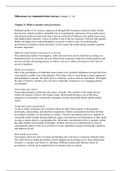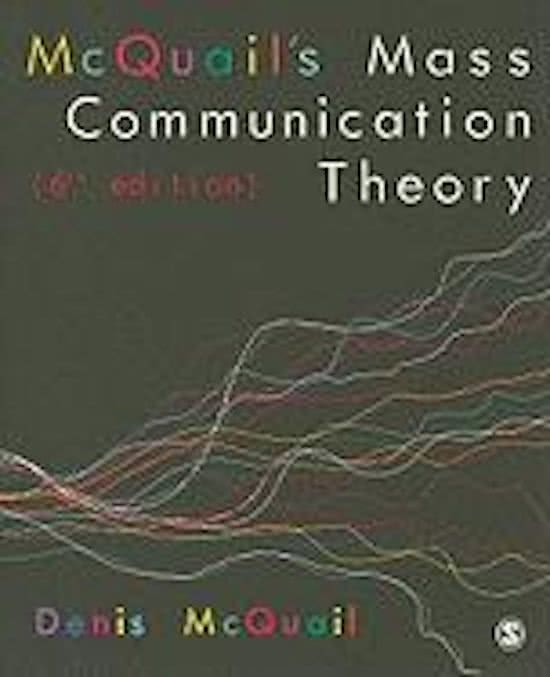Milestones in communication science (chapter 9 - 14)
Chapter 9: Media economic and governance
Mediated politics is by citizens experienced through their broadcast and print media. Media
has become central to politics and public life in contemporary democracy (how media report
and interpret political events and issues, & how media itself influences the political processes
and shapes public opinion). Access to media is one of the key measures of power and equality
Media can shape power and participation in society in native ways, by promoting the
involvement of people in those decisions. In this respect the media and governance equation
becomes important.
Different media markets and sources of income
The mainstream media of newspapers, radio and television can be classified according to a
fundamental line of economic division between the consumer market for media products and
services and the advertising market, in which a service is sold to advertisers in the form of
access to audience.
Media cost structure
One of the peculiarities of traditional mass media is the potential imbalance between the fixed
costs and the variable costs of production. The former refer to such things as land, equipment
and distribution network. The latter refer to materials, such as software and labour. The higher
the ratio of fixed to variable costs, the more vulnerable a business is to a changing market
environment.
Ownership and control
Ownership ultimately determines the nature of media. The contents of the media always
reflect the interests of those who finance them. Most media belong to one of the three
categories of ownership: commercial companies, private non-profit bodies and the public
sector.
Competition and concentration
As far as media economics are concerned, there are three main aspects to the question:
intermedia, intramedium, and interfirm competition. Media concentration has been divided
according to whether it is horizontal or vertical. Vertical concentration refers to a pattern of
ownership which extends through different stages of production and distribution (a film studio
owning a cinema chain), or geographically. Horizontal concentration refers to mergers within
the same market (cross-media ownership). Another relevant set of distinctions by type of
concentration relates to the level at which it occurs: publisher/concern (ownership), editorial,
and audience levels.
Mass media governance
Governance refers not only to formal and binding rules, but also to numerous informal rules.
The main forms of media governance can be mapped out according to two main dimensions:
external vs. internal, and formal vs. informal. Different media need different forms of
governance. Control can be applied more to structure than to content.
, The regulation of mass media (and alternative models)
Different media have been subject to different types and degrees of regulation. The
differences are related to four main factors: first, the strength of a medium’s claim to freedom,
especially in the light of its typical content and uses; secondly, the degree to which a potential
harm to society is perceived; thirdly, for reasons of equitable allocation; and finally, the
relative practicability of effective regulation. Three models have been identified; the free
press model, the broadcasting model, and the common carrier model.
Indexing/indexation theory an implicit calibration process conducted by the press corps
creates a weighting system for what gets into the news, what prominence it receives, how long
it gets covered, and who gets the voice on stories.
Conclusion
This chapter provided an overview of the main features of media economics and of the system
of regulation (governance). Both show distinctive features compared with other industry
sectors. The key to differences in both cases is the dual character of media, being both a
commercial enterprise and a key element in the political, cultural and social life of society.
They cannot be left entirely to the marketplace or be closely regulated.
Chapter 10: Global mass communication
The pace of internationalization has accelerated because of advances in distribution
technology and new economic imperatives. The mass media are affected by the general
phenomenon of globalization. Nationalism and imperialism encouraged an interest in
international events. Television is still the single most potent influence in the media
globalization process. Another new force for internationalization is the Internet.
Media concentration means that the world media industry is increasingly dominated by a
small number of very large media firms. The rise of the global news agencies was made
possible by technology, and stimulated by war, trade, imperialism, and industrial expansion.
The mass media were viewed as one of the most promising channels of modernization (or
westernization). Most of the issues surrounding global mass communication have a direct of
indirect connection with the thesis of cultural (media) imperialism (an attempt to dominate,
invade or subvert the ‘cultural space’ of others and suggest a degree of coercion in the
relationship. It is certainly a very unequal relationship in terms of power.
There has been an enormous expansion of television production and transmission. More
recent attitudes in Western Europe to importing audiovisual content have been shaped by
three main factors, aside from expansion and privatization. One has been the political-cultural
project of a more united Europe. The second has been the goal of creating a large internal
European market, in which European audiovisual industries should have their place in the sun.
Thirdly, there was a wish to reduce the large trade deficit in media products.
A recurring theme of debate and research arising out of media globalization concerns cultural
identity. Imported media culture is thought to hinder the development of the native culture of
the receiving country. National or cultural identity is a general concept of a collective identity.
One cultural consequence of media globalization is the rise of a globalized media culture.
Media internationalization probably does lead to more homogenization or cultural
synchronization.





